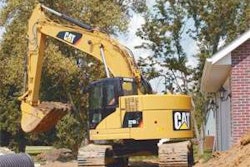 Trimble’s Gary Chisolm dishes on GPS
Trimble’s Gary Chisolm dishes on GPSOn Tuesday during Trimble’s Dimensions 2012 conference in Las Vegas, the company’s Gary Chisolm led a crash course in understanding the basics of how GPS functions and important things to remember when setting up GPS equipment on the jobsite.
He started by explaining that all GPS receivers require at least four satellites in order to determine the three factors of location: longitude, latitude and elevation. However, if you need precise positioning, down to within a few centimeters for instance, that receiver will need to lock on with five satellites.
With that in mind, GPS receivers can’t make that connection under concrete, water or heavy folliage. So keep clear of those things on the jobsite. And when setting up a GPS receiver or base station on your site, make sure it’s clear of any trees and a good distance from any buildings or overhangs. Chisolm said that most of the problems he sees with GPS base stations have to do with where they are placed.
Another common problem is what Chisolm referred to as “multipath reflection” where GPS signal is reflected between water and buildings as it travels between the satellites above and the GPS receiver on the ground. Chisolm said that a higher radio antenna can typically fix this problem or you can set up a repeater that relays the signal around any obstructions such as hills.










